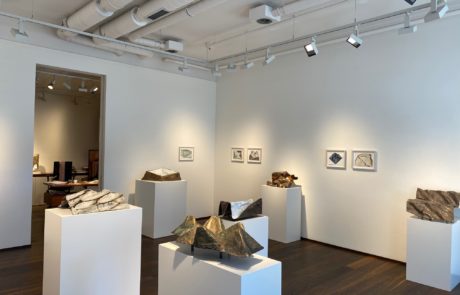From 1963 to 1992, Cimiotti was professor at the Stattliche Hochschule für Bildende Künste in Braunschweig and is one of its co-founders. His works were shown at the Documenta II and III and the Venice Biennale and, he received numerous awards and honors. Within the art history of the second half of the 20th century, he occupies a special place, as he developed a technical process that proved to be groundbreaking for modern sculpture: the lost wax process.
As the artist himself explains: “Until then, the path in sculpture had led almost exclusively from the sketchy idea sketch to the small model, then from the model to the scaffolding and from the scaffolding to the construction of the object. These three steps were combined to create a direct and immediate approach to the execution. Wax was the ideal material for this, because it allows constant changes until the final stage, but also allows the greatest possible degree of spontaneity…”. This process allows the organic transition from creation to execution and to the final form in more stable material in direct succession. About his working method Cimiotti says
“…(a) sequence of, for example, cells, honeycombs, caverns – of spaces specifically assigned to one another/ This coincides with the simultaneity of inside and outside. Inside and outside are identical. This creates new contents, fields of association, ‘landscapes’, ‘mountain formations’, ‘zones’, ‘inner worlds’, ‘earth crusts’ or also ‘matter’, ‘lumps of flesh’, ‘injuries’, ‘cuts’…”.
In terms of content and form, the sculptor makes no distinction between the landscape and the physical. And it is irrelevant to him how, whether and to what extent he distances himself from the representational in individual works and at times approaches it again. What is important for Cimiotti is that he remains true to his principle of “transitions” and develops it further. He creates groups of figures and complex structures, he designs sculptures similar to swinging bands or stripes, he makes abstract trees, mountains, steps and craters, and yet he is only interested in the essential in them. In 1962, he wrote down what fascinated him: “Matter, but not the permanent, the compact, but the temporary, the transitory…” – transitions.
Especially in the discourse of the currently vehemently changing world, these works vividly depict the plurality and change that constitute the firm principles of human existence, but which are all too often ignored. In this respect Cimiotti’s works prove to be more topical than ever.
Galerie Haas is pleased to present 10 sculptures by Cimiotti and 13 drawings, the latter of which are also to be understood as independent works. The exhibition is accompanied by a catalog in German and English.




